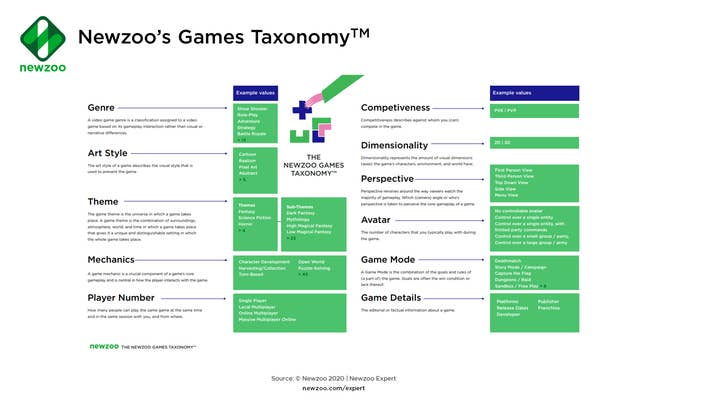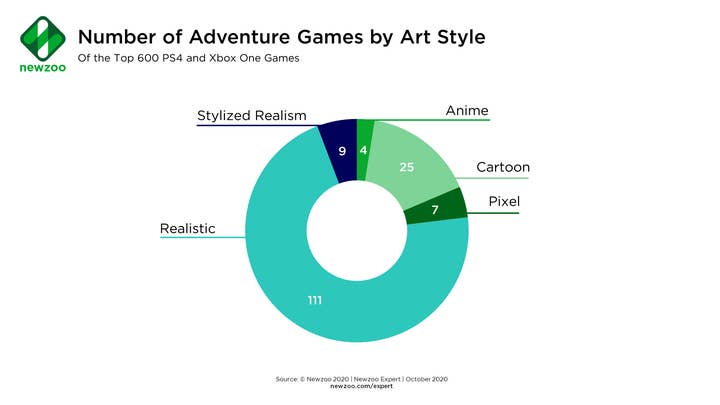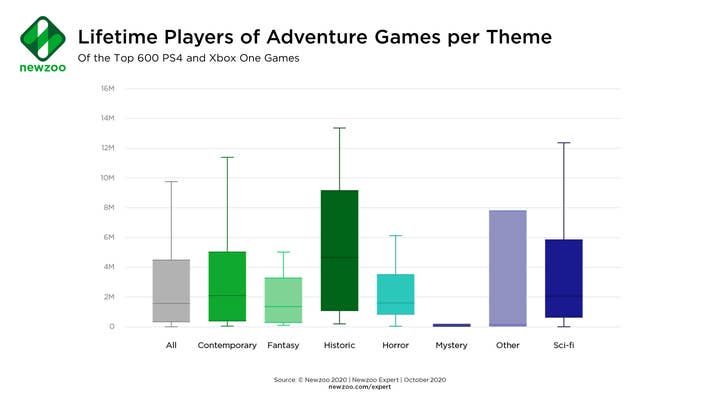Beyond genre: Using taxonomy data to build your next big game
Finding your game's perfect market fit with Newzoo's Games Taxonomy
Whether you're in the conceptualization or execution phase of game development, deciding on the elements needed to become successful in a saturated market is challenging. Even with large sets of data available, it is difficult to understand how a specific mechanic or art style choice can influence a game's performance. One solution is to utilize a taxonomy system that allows you to view the data through any lens, allowing for actionable analysis.
Widening Your Horizons With Games Taxonomy
Our taxonomy-based data analysis in Newzoo Expert is powered by Newzoo's Games Taxonomy, which breaks down games into their core elements across 11 different categories including genre, art style, theme, and even the core game mechanics and game modes. Leveraging this taxonomy and combining it with our data tracking across every major platform -- not only PC, mobile and console player data, but also viewership and social media engagement data, we can highlight the exact types of games and game elements we want to analyze.

When It Comes to Analyzing Games, More Is More
In Newzoo Expert, we've already tagged thousands of games according to the 11 categories above, which alone can give you some great insights into what elements make for a successful game.
To show the foundations of our taxonomy in action, we'll look at two of 2020's biggest adventure games: Assassin's Creed Valhalla and Marvel's Avengers. Both feature realistic art styles, a single-player game mode, and third-person viewpoints.
However, Assassin's Creed Valhalla is a historical-themed game and Avengers is a fantasy-based game (in this case, superheroes). Marvel's Avengers also features online cooperative multiplayer, while Valhalla focuses on single-player gameplay alone.

Of course, developers can deduce these themes and elements for themselves using gameplay and screenshots; however, where this data really shines is when developers leverage it to look at the overall games landscape for specific game types.
Does a historical-based theme fit a given game type? Is online multiplayer effective for selling more copies of a certain style of game? Just a few clicks in Newzoo Expert empowers developers to answer these questions --and with hard data to boot. Let's explore some of the features our developer users love.
Building an Adventure Game on Console: Themes
To start off, it is useful to understand the overall landscape of adventure titles in terms of art style and themes. Both of these topics represent a fundamental aspect that a game must decide on very early in its development cycle, and can have a large impact on its potential in the market.
After filtering by ''adventure games'' in the console games ranking table, we saw that the top adventure games cover many themes:
- Sci-fi was the most prominent theme, used by 46 adventure games in the top 600
- But other major themes, like fantasy and horror, are also well represented
- And contemporary and historic weren't far behind

This breakdown shows that the adventure genre synergizes well across most themes, meaning adventure titles with practically any theme can reach the top 600 if executed well. However, there are some gaps in the market, and gaps can lead to opportunities.
Mystery adventure games, for example, are an underrepresented theme in the adventure genre, which could point to untapped potential --or it could mean that the theme has not resonated with adventure game fans in the past.
Gaps in Art Styles: Another Place to Look for Opportunities
Breaking down the same group of adventure games by art style paints a different but equally interesting picture. Most adventure games feature a realistic art style. But as you can see below, anime represents the smallest share of these games.

Is anime an untapped segment in the West? The recent launch success of Genshin Impact, a free-to-play adventure game with an anime art style, seems to suggest so.
Again, this data is valuable, but most of our platform users go beyond diving into popularity vs. saturation for titles. The question many ask is how many players can I forecast if I build a game with a specific element? And our custom sets help them answer these questions.
Taxonomy Filtering With Custom Sets of Games
Newzoo Expert allows users to filter any of our taxonomy elements across all our data tables, including PC, mobile, and console. This filtering lets users focus on the games that match their criteria, removing any irrelevant data points.

Still focusing on themes, we can dive into an analysis of lifetime players per theme. An effective way to forecast different scenarios is to use a box-plot and percentile analysis -- instead of analyzing the average number of players alone.

The above chart shows that not only is mystery the least common theme in adventure titles, it also has the least console players, while historic-themed games have the most players across most percentile ranges.
Comparing our previous two examples of fantasy and historic, we can see that the median-performing historic titles have almost as many lifetime players as the max percentile for fantasy. Surprisingly, fantasy also is one of the lower-performing themes in the genre.
Not only does this analysis help us understand which themes perform better for specific genres, but we can also easily start to project different performance scenarios. For example, taking the Q1 (25% percentile) as low, median (50% percentile) as mid, and Q3 (75% percentile) as high, we can run a high-mid-low performance scenario. Understanding a projected performance range can be invaluable when deciding between different game ideas -- especially when it comes to greenlighting or planning budgeting for development and marketing.
Bringing Gameplay Mechanics Into the Mix
To analyze potential performance even deeper, we could break down and combine even more elements. For example, would adding multiplayer to a historic-themed adventure game influence performance?
We added another element to our filter for some game mechanics that may be worth considering, letting us analyze the influence of certain mechanics on our historic-themed adventure (in terms of lifetime players):

On the surface, the performance of these different mechanics seems relatively similar. Yet, if we consider the performance of games with puzzle-solving vs. those with stealth or open-world elements, we see that the median-performing game for stealth and open-world perform better than the 75% percentile of puzzle-solving titles.
Taking Your Game Development to the Next Level
Analyzing game performance across taxonomy elements is one useful process to decide on the right game elements to help your game find the right market fit. Hopefully, this guide provides a new tool to smoothen the process of greenlighting and building a new game for success. To learn more about using Newzoo Expert data to help find that success in your next game, get in touch at tyler.long@newzoo.com.
Company and author bio
Newzoo is the world's leading provider of games and esports analytics. We're proud to help some of the most successful entertainment, technology, and media companies-such as EA, Bloomberg, PepsiCo and Vodafone-target their audience, track competitors, increase brand awareness, spot opportunities and make strategic and financial decisions. Tyler Long is our Game Development & Publishing Market Lead.
